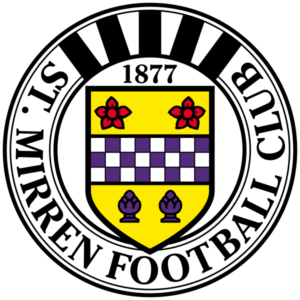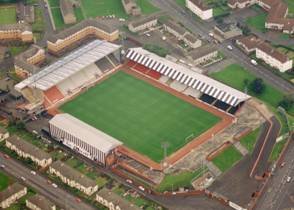
As part of my role as Scottish correspondent for Groundtastic magazine I wrote a number of club articles dedicated to a particular stadium. I hugely enjoyed visiting new towns and cities to unearth some architectural gems of the football world. As a roving reporter I visited Caledonian Stadium, Firs Park, Victoria Park, Borough Briggs, and completed a tour of the football grounds of the Highland League to name but a few.
I have recently been watching the vlogs of Footy Adventures, which I would heartily recommend to those of you who are interested in football stadiums and architecture. These vlogs are exactly the sort of thing that I would have been producing if things were different. Sadly, I have been held back by a progressive, genetic disease of the nervous system, the related disability, a lack of technical expertise to produce videos and being in Scotland at the wrong time, with the wrong person.
I suppose what I have done as an alternative is to write Every Silver Lining has a Cloud, which is an autobiographical tour of the Welsh Premier League football grounds. For those who have yet to read it – shame on you. I am happy with my own contribution to the world of football architecture, but I can’t help having feelings of envy and jealousy as I watch the ever increasing body of vlogs produced by Footy Adventures.
I have decided to reproduce the club articles and photographs that I managed to take during my time in Scotland. This was a difficult time for myself as I was beginning to feel the full effects of living with Friedreich’s Ataxia. It would obviously difficult having to rely on trains to get me to my desired destination and the fact that I was losing my dexterity meant that it was increasingly difficult to take decent photographs.
This is actually the final article that I have in my Groundtastic folder and I will not be able to share any other pieces written while enjoying my time as Scottish correspondent to this football ground magazine. I now hope to concentrate on finishing the Wrexham AFC book that I have been working on since 2015 and then finding the time to create the collages that I have been threatening to turn my hand to for a few years now. I also have ideas for yet another book, so there are plenty of exciting projects that lie ahead…
Overall, I am happy with my contribution to Groundtastic magazine between 2002-2008, and hope the articles that I have shared other the past few months have been of interest to some of you.
***

At the time of going to press, St Mirren are seven points clear at the top of the Scottish First Division and are favourites to win promotion to the SPL. Should the Buddies hold on to pole position until the end of the season their first season back in the top flight could be their last at St Mirren Park, or Love Street as the fans insist on calling it.

As it stands, Love Street has an all-seated capacity of 10,800 and is a charismatic mix of old and new styles.

The Main Stand is the oldest and smallest of the four stands and straddles the halfway line. It is a simple top-level structure with windbreaks, though a small enclosure has been added to the front to increase the stands capacity. This stand also includes changing rooms, club offices and the boardroom.

Directly opposite the Main Stand is the substantially larger LDV North Stand, or North Bank, as it is commonly known. This covered, seated terrace holds 4,146 and is accessed via a large ramp, which stretches from the North-East turnstiles over the corner and into the back of the stand. This structure is distinguished by the distinctive black and white stripes painted on the roof of the stand.
The Reid Kerr College Family Stand is a 2,200-seated terrace with cantilevered roof. It was built in 2000 to comply with the SPL’s 10,000-seat rule when the money used was needed to strengthen the playing squad. St Mirren were understandably angry when the SPL relaxed their criteria to allow Inverness CT to groundshare with Aberdeen and then lowered the necessary seating capacity to 6,000. From inside the ground, the single tiered stand doesn’t look anything special but from the exterior you can see the splendid crumbling staircases that supporters have to climb to gain entry to the stand. This old-fashioned feature may be dated but it certainly adds some character to an otherwise bland looking stand.

Away fans are given the Caledonia, or West, Stand, which opened in August 1995 at a cost of £1.4 million – £1m of which came from the football trust. 3,015 seats are accessed from an open flight of stairs on one side of the stand leading to a wide concourse at the top. This is because the entire undercroft is taken up by five-a-side pitches and a health club, whose facilities are shared between St Mirren, private members and the community. The club, local councils and the Scottish Sports Council raised the £500,000 costs of the centre.
Love Street does not yet boast undersoil heating but plans are in place to have it installed should Gus MacPherson’s men win the championship crown in May.
However, if things go according to plan Love Street will soon be sold for retail development to pay off the clubs spiralling debts and fund a new purpose built stadium in the Greenhill Road area of Paisley. Saints chairman Stewart Gilmour claims that the move is essential to the long-term survival of the club.
On paper, the proposed new ground looks as sterile as any other new build stadium and lacks the quirky features that makes Love Street so appealing. However, with the financial situation as it is, this is the best option available.

Greenhill Road will eventually boast a 10,000-seat stadium, costing in the region of £8 million. The ground will be closely modelled on Airdrie United’s New Broomfield stadium with four separate single tiered stands. In addition, it is thought that indoor training and leisure facilities will be created along with 5-a-side pitches for the club and local residents to use. Greenfield Road is half a mile away from the club’s current Love Street site.

While this all sounds good in theory, St Mirren haven’t actually sold Love Street yet, although they are in talks with a couple of interested supermarket chains. Subsequently, work has yet to start on the stadium in Greenhill Road yet the club are still maintaining that they will be in their new home for the start of the 2007-08 season.
The next few months will be crucial for the Paisley club, both on and off the field. Not only do they need to maintain their dominant form in the league but it is essential that the sale of Love Street is pushed through soon – if only for the sake of the clubs finances.
|
1877 – St Mirren formed 1894 – Moved to Love Street 1905 – Bought Love Street for £3,900 1921 – Main Stand opened 1949 – Record attendance of 47,438 against Celtic in League Cup 1959 – Floodlights turned on for cup tie versus Peebles. 1977 – Love Street designated under the Safety of Sports Grounds Act 1990 – Ordered to close West Terrace after Taylor Report 1995 – Caledonia Stand opened 2000 – Reid Kerr College Stand opened |
|
Paisley Museum and St Mirren Independent Supporters Association (SMISA) are planning an exhibition to commemorate the club’s 112-year connection with Love Street. The exhibition – planned for May 2006 – will demonstrate how the fortunes of the town of Paisley and those of St Mirren have been interwoven together during the last century. Supporters with memories, anecdotes or memorabilia related to St Mirren and Love Street in particular are being asked to get in touch with event organisers to help make it a success. |

